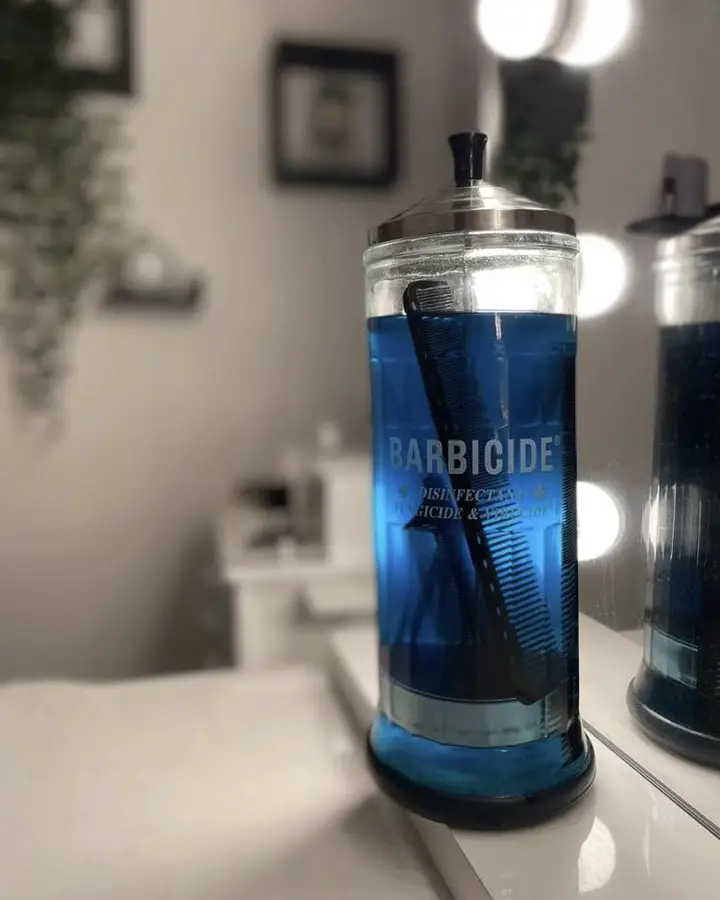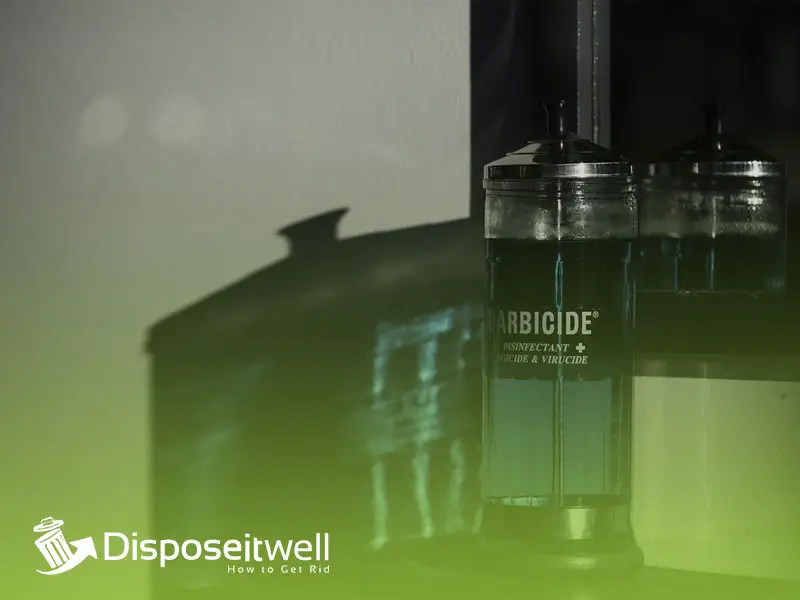Every day in the salon, your and your client’s safety should be your primary priority. However, the emergence of novel pathogens should serve as a timely reminder of the significance of following established protocols for infection management.
According to OSHA guidelines, barbicide is considered a hazardous substance. The liquid and vapor are very flammable. If it gets in the eyes, it can irritate them very severely. Nausea, vomiting, and diarrhea are also possible side effects of ingestion. It could be irritating to the skin if it makes contact with it. Redness, swelling, dryness, loss of fat, and cracking are all possible side effects of barbicide. Therefore it is vital to dispose of Barbicide in the right way. In this article, we’ll let you know what is Barbicide and how to dispose of it properly. So, keep reading.
What is Barbicide?
The term “barbicide” refers to a disinfectant solution that barbers and cosmetologists utilize to sterilize grooming equipment like combs and hair-cutting shears. Barbicide is a combination of disinfectant, pseudomonads, fungicide, and viricide licensed by the Environmental Protection Agency of the United States. It is effective against HIV-1, hepatitis B, and hepatitis C. It also contains sodium nitrite and blue dye in its active component, alkyl dimethyl benzyl ammonium chloride, which accounts for 5.12% of its content.
How to Dispose of Barbicide
In compliance with all state, regional, and national standards governing the environment, BARBICIDE that has been diluted can be safely disposed of down the sink or the drain. For additional information and clarity, please get in touch with your local municipality.
Precautions When Using Barbicide
- Avoid contact with skin and clothing.
- Put on some protective gear for safety (goggles, face shield).
- You should use soap and water to clean your hands after handling them.
- Take off any potentially contaminated items and wash them before reusing them.
- Keep out of reach of eyes and skin
- Don’t let the spray mist get into your lungs.
- Every time users eat, drink, chew gum, smoke, or use the restroom; they must wash their hands.
- This product should not be used or stored in a hot or draughty area.
- Do not store or dispose of it in a way that could contaminate water or food.
- Always keep products in their original, tightly sealed packaging, and place them in a clean, separate space to avoid contaminating other substances.
- Don’t keep it where the temperature will fluctuate wildly or where they will be exposed to direct sunlight.
- The dangers posed by barbicide residues are severe, and Federal law prohibits the illegal disposal of unused barbicide, spray mixture, or rinsate. If you cannot dispose of these materials by using them as directed on the label, please contact the State Pesticide or Environmental Control Agency or the Hazardous Waste representative at the nearest EPA Regional Office for assistance.
- Disposable packaging with a one-time use-only option. Please do not fill or reuse this container.
- If you can recycle it, do so.
How to Disinfect with Barbicide

Bring Barbicide together in proportions. Mix 1/4 cup Barbicide Concentrate with four glasses of water. All pathogens will be eliminated at this concentration. Only use this in states where Tuberculocidal is not mandated.
It’s important to sterilize all of the salon’s nonporous surfaces. Nail files and neck strips are disposable objects that should be tossed aside after each usage. When you have your disinfectant solution ready, you may use it in several ways. Immerse it if you can. Spray it if you have to.
Items like combs, shears, brushes, and nail clippers can be immersed in barbicide for 10 minutes. As long as the recommended contact period (on the label) is met, no trace of the listed pathogens will remain.
After the allotted time, take the tools and give them a quick rinse. Keep the tools protected from the air until you need them again. After 24 hours, or sooner if polluted, you should change the solution that has come into contact with your tools.
While you could dip chairs and counters in Barbicide, it seems a lot of extra work when you only have to spray them. Counters, seats, mirrors, and sinks should all be sprayed down.
The ten-minute contact duration is required for effective infection prevention. Following these simple instructions for applying Barbicide, you’ll be well-equipped to maintain a sanitary salon environment.
Can You Drain Barbicide Down the Sink?
Only diluted quantities of less than one gallon can be flushed down the toilet. According to the MSDA guidelines on barbicide, more than one gallon of the substance must be transferred to a waste disposal location in its undiluted form.
For How Long Do You Leave Tools in Barbicide?
When it comes to equipment such as combs, shears, brushes, and nail clippers, you should submerge them in barbicide for 10 minutes. During those ten minutes (the contact time), all pathogens listed on the label will be eliminated. After the allotted contact time, the tools should be removed and washed with water.
FAQs
Is Barbicide Fammable?
Barbicide is highly flammable and should be kept from any direct heat source.
Is Barbicide Toxic?
Barbicide is toxic, and ingesting it can cause stomach upset, nausea, vomiting, and even diarrhea. Contact with the skin can be irritating at times, and redness, swelling, dryness, loss of fat, and cracking are all possible side effects.
What if You Ingest Barbicide?
Barbicide is poisonous, and ingesting it can cause stomach upset, nausea, vomiting, and even diarrhoea.
Verdict
A violation of federal law occurs when different pesticides, spray mixtures, or rinsates are disposed of improperly. The wastes generated as a result of the use of these products can be disposed of on-site or at a waste disposal facility authorized. When getting rid of barbicide, you need to make sure to dispose of it properly.
My name is Ella Vicedomine and I’m the founder of this blog. The aim is to start this informational blog to guide people on how to dispose of waste things around in the house but in the right way.

